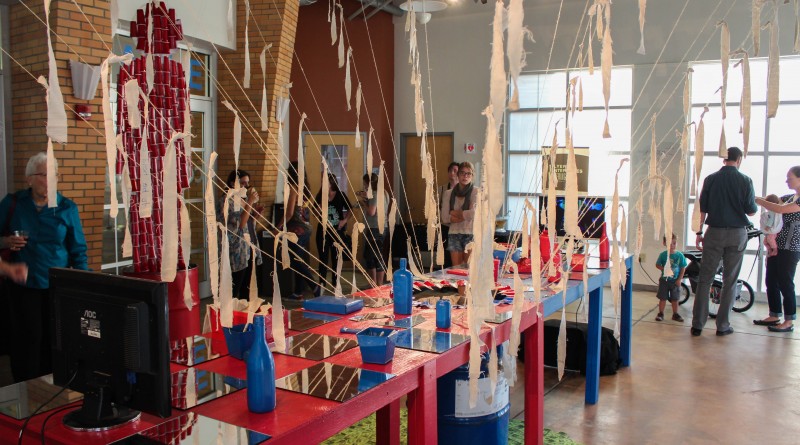ArtStreet installation: Have we become too greedy?
By: Kwynn Townsend-Riley – Staff Writer
ArtStreet debuted its second installation, CONSUMPTION, for its Institute for Arts Nexus series at the University of Dayton.
The CONSUMPTION exhibit was designed by Creative Lead Sean Foster, who took on the position last spring. CONSUMPTION seeks to leave participants “thinking more carefully about how all the moving parts of our society are not only connected, but also interchangeable,” said Foster, “[w]hat we have now does not have to be the only way.”
Foster has attempted to bridge gaps between commercial and the ‘fine’ arts, incorporating the tenets of mass production and communication through sensory experiences.
“As a designer, much of the work I do every day is based on problem-solving,” Foster said. “These problems might weave in and out of communication and language, but also how to describe complex topics through visual storytelling. For the past five years especially, I am very interested in how the worlds of art and design meet, blend, and interact. How can these two explorations work together? Why are they even considered separate? Why is one considered a commercial pursuit, the other cultural?”
Walking into the exhibit was facing my materialism and obsession of media in the face. All of the wants that were written on the walls for the exhibit THIRST had been transcribed onto threads that are ingested by the never ending garbage can of capitalism. There is a sense of not only guilt, but also vulnerability when you walk in and see George Bush at the dinner table and a plethora of advertisements to spend your money, simultaneously. In addition, your plate is your mirror, playing off the common saying “you are what you eat”. Forcing any person to answer, “What is an American?” Because this exhibit is four-dimensional, there is encouragement for emotion: a wall where participants can confess their fears. I saw fears range from farts to Donald Trump to failure to dying as a black woman.
The exhibit also features television screens featuring videos that are collages of found footage which draw from our nation’s political past as well as its tie to a system of economics that is not necessarily beneficial either to humanity or to our shared home.
“The blue video takes Bush’s speech after 9/11 as a starting point. I was fascinated by how our nation rallied behind a tragedy, but also how the leader of our nation had to encourage us to buy things and support the economy in said rallying,” said Foster. “The other video is called red and is meant to exist in conversation with blue. Red takes Eisenhower’s warning about the ‘military industrial complex’ as its starting point. The foreboding is undeniable when layered with found footage of atomic bomb tests and a hypnotic commercial played directly after the announcement of JFK’s assassination on television. Perhaps one video predicts the other, or they interrupt one another. Are they part of one conversation, or two distinct dialectics?”
In addition to this chilling and conscious installation, there is “Dinner in the Desert Kitchen” on Wednesday, Oct. 28 from 7-8:30 p.m. It’s a program that is happening in conjunction with CONSUMPTION and in collaboration with Campus Ministry’s Center for Social Concern. Centered around the concept of Dayton being a food desert, this event is PATH eligible.
“I thirst for the future to be filled with problem-solvers and devoid of the greed so prevalent in our present tense. I consume way too many words, too much Netflix, and too much Internet. I eat like a growing boy, and love a good pint,” said Foster. “I fear the earth will overcome humanity’s ego before we learn to work as a care-taking part of its beautiful complexity.”
Photo: CONSUMPTION will be in the White Box Gallery at ArtStreet until Nov. 5. Photos courtesy of Adrienne Ausdenmoore.


